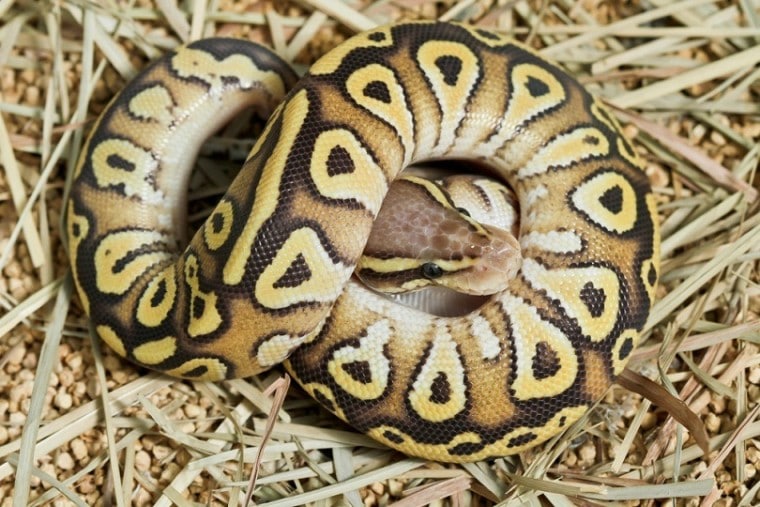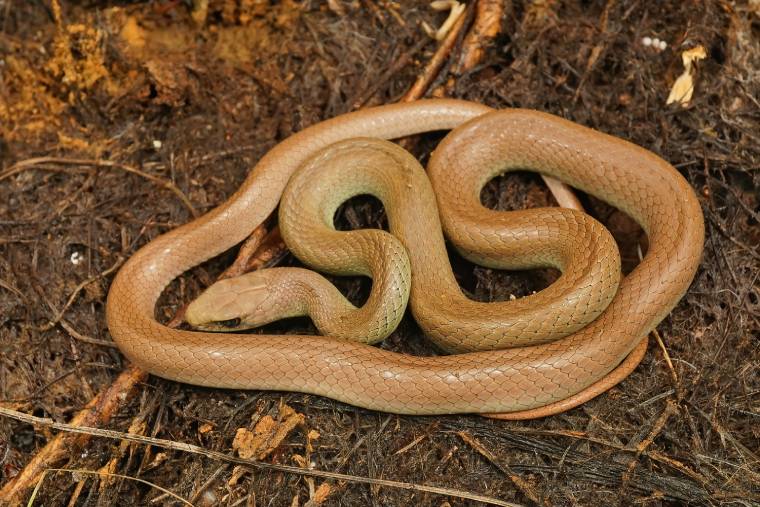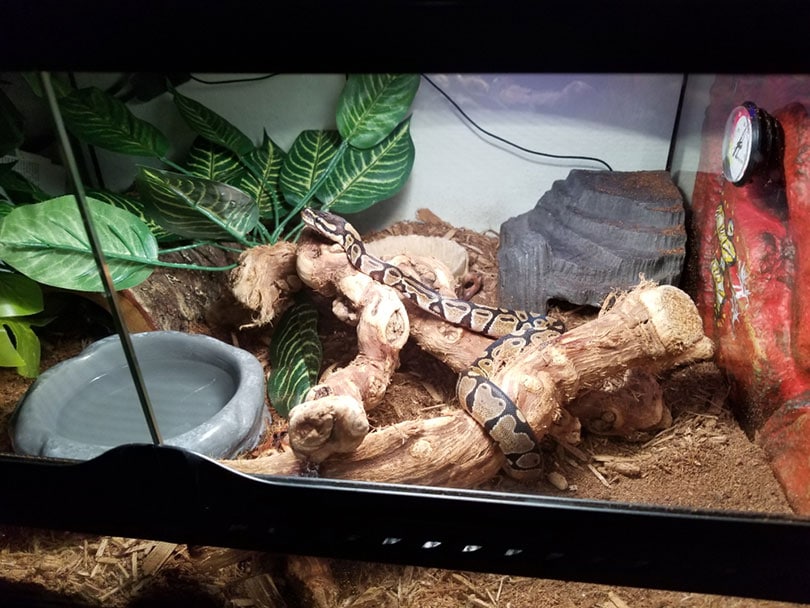
The Butter Ball Python Morph or simply Butter Ball or Butter as it’s also called is a highly sought-after snake with soft coloration. This popular ball python morph was developed in 2001 and is a co-dominant mutation.
The Butter Ball Python Morph looks a lot like the Lesser Ball Python that was developed around the same time as the Butter Ball. However, the two snakes are not the same because they have different lineages that simply stem from the same morph.
Except for the coloration, Butter Balls are the same as other ball pythons with males reaching 2 to 4 feet in length and females growing to 4 or 5 feet long.
Quick Facts about Butter Ball Python Morph
| Species Name: | Python regius |
| Common Name: | Butter Ball, Butter |
| Care Level: | Easy |
| Lifespan: | 20-30 years |
| Adult Size: | 2-5 feet |
| Diet: | Carnivore |
| Minimum Tank Size: | 30-gallon |
| Temperature: | 78°F temperature |
| Humidity: | 40-60% humidity |
Do Butter Ball Python Morphs Make Good Pets?
Like other ball pythons, the Butter Ball makes a great pet for just about anyone. These reptiles are mellow, beautiful to look at, and low-maintenance. This snake is considered a good pet for a new snake owner.
If you’re thinking about getting a Butter Ball Python Morph, keep in mind the fact that this snake lives for around 30 years when kept in captivity. This means you must be willing to commit to owning a snake for several decades. These snakes require regular care and maintenance, even though they’re considered easy to keep.

Appearance
The Butter Ball is a beautiful snake with yellow markings on a velvety caramel-brown background. The snake’s genetics make its dark colors lighter than normal. The Butter Ball is a stocky snake that can grow between 2 and 5 feet in length and weigh between 3 to 4 pounds (1.4 to 1.9 kg).
How to Take Care of a Butter Ball Python Morph
Habitat, Tank Conditions & Setup
To ensure your Butter Ball Python Morph enjoys a high quality of life, you must provide him with excellent care and maintenance. This includes, among other things, providing your snake with a proper habitat he’ll be comfortable living in. Your goal should be to create an environment that’s similar to the ball python’s habitat it’s used to in its native Africa.
In the following section, we’ll explain what you need to keep in mind when selecting and preparing your snake’s enclosure. We’ll also cover the lighting, heating, and substrate your Butter Ball needs.
Tank
A glass terrarium is a good type of tank for a Butter Ball as it offers you the ability to watch your pet with ease. Look for a tank with a raised bottom panel that allows you to mount a substrate heater or heater cable. The tank should also have a removable mesh screen that creates optimal airflow and allows for UVB light penetration.
The Butter Ball Python Morph needs a 30 to 40-gallon tank which gives it plenty of room to move about. This snake does well living in an enclosure that’s 36” W x 12” D x 18” H. The tank should be kept relatively barren as ball pythons don’t require a biologically diverse habitat.
It’s very important to keep your Butter’s tank clean. At the very least, you should do a thorough tank cleaning once a month. This involves relocating the snake and cleaning all the sides and components of the enclosure and replacing the substrate.

Lighting
Butter Ball Python Morphs do best with a 12-hour light cycle. These nocturnal snakes are the most active during the nighttime which means you’ll need to ensure there are no powerful lights on once the sun goes down.
Supplemental lighting isn’t a must-have for a Butter Ball, but if used, it should be on a 12/12 cycle meaning 12 hours on and 12 hours off. Just be sure not to use a bright overhead light that will make your snake feel stressed.
Temperature & Humidity
A Butter Ball is a cold-blooded animal that regulates its body temperature. To help your snake do this, one side of the tank should be kept at 78°F (the cool side) and the warm side should be between 88°F and 96°F. This allows your snake to move to the side of the tank it needs to feel comfortable. You can use a ceramic heat emitter or an under-tank heating system to set the ideal temperatures in your snake’s tank.
A Butter Ball Python Morph requires a 40-60% humidity level. Use a hygrometer to make sure the humidity in your tank keeps within this range to keep your snake healthy and happy.
Substrate
A Butter Ball enjoys a substrate made of cypress mulch or orchid bark. Another option that is cheaper is to simply use newspapers or paper towels as substrate. One type of substrate to avoid is cedar because it contains harmful oils.

Tank Recommendations
| Tank Type: | 30 to 40-gallon glass terrarium |
| Lighting: | 12 hour light cycle |
| Heating: | Ceramic heat emitter or under-tank heating system |
| Best Substrate: | Cypress mulch |
Feeding Your Butter Ball Python Morph
Providing your Butter Ball Python with food is a simple, straightforward process. However, feeding your snake must be done with care because a Butter Ball can bite.
Butter Ball Python Morphs live on mice or rats in captivity. Young Butters are happy eating small mice. As they grow larger, you can gradually move onto large rats. Just be sure to feed your snake mice or rats that are no bigger than the widest part of the snake.
Butter Balls can eat live or frozen mice or rats. If you decide to feed your snake frozen food, be sure the animal is thawed before feeding it to your snake. If you decide to feed your snake live mice and rats, be present while your snake eats to ensure the mice or rats don’t harm the snake. If you have a juvenile snake, it needs to eat once per week. If your snake is an adult, you should feed it every two weeks.
Diet Summary
| Meat: | 100% of diet – small/medium-sized mice and rats |
| Supplements Required: | N/A |

Keeping Your Butter Ball Python Morph Healthy
It’s relatively easy to keep a Butter Ball Python Morph healthy by providing it with a proper habitat, regular food, and fresh drinking water. It’s a good idea to give your snake a bowl of water that’s large enough for him to crawl in and take a nice soak now and then. Just be prepared to clean and disinfect the water bowl every week.
Common Health Issues
While the docile Butter Ball Python Morph is a very hearty animal, this snake can have some health problems. Some health issues common with these snakes include:
Lifespan
In the wild, ball pythons only live for about 10 years. However, when kept in captivity, these snakes can live up to 40 years. The reason these snakes have shorter lifespans in the wild is that they’re non-venomous, making them easy targets for predators like other snakes, large birds of prey, wild pigs, leopards, and warthogs. Humans also hunt ball pythons in their natural habitat to use them as food and to sell their skins.
Breeding
Ball pythons breed well when kept in captivity. This is why hobbyists have been able to develop so many morphs. Breeding these snakes requires knowledge of python behavior and genetics. If a pairing mistake is done, the morphs can be born with inherited neurological problems.
It’s not a good idea for a novice to breed Butter Ball Python Morphs as it takes knowledge to do correctly. If you want to learn how to breed your Butter, educate yourself to learn how to assess, pair, incubate, and hatch ball pythons. A good way to learn how to breed Butters is to join pet forums online where ball python owners meet to share information and learn from each other.
Are Butter Ball Python Morphs Friendly? Our Handling Advice
Butter Balls are generally shy and spend most of their time hiding. Initially, your Butter may see you as a threat. With time, your snake will learn not to be afraid of you so you won’t be viewed as something to fear.
When handling your Butter, avoid fast movements. Many Butter Balls try to hide when handled and some even bite due to fear. Once your snake realizes that you’re not going to hurt him, he’ll try not to get away from you to hide.
If your snake looks like he wants to strike, it’s best not to handle him. Always be relaxed when holding your snake and sit down to give him a chance to settle.
Shedding & Brumation: What to Expect
The Butter Ball Python Morph sheds its skin every 4-6 weeks. However, younger ball pythons shed more frequently than older snakes, so the time between sheds can vary. When a Butter is shedding, the snake will often become more sensitive and even aggressive because it’s an awkward and irritating process for the snake. This is why you should avoid handling your snake during the shedding process which typically takes less than 14 days.
Brumation is a hibernation-like state that cold-blooded animals go into during very cold weather. Because ball pythons are native to Africa, these snakes do not brumate.

How Much Do Butter Ball Python Morphs Cost?
Butter Ball Python Morphs are not expensive snakes to buy. You can easily find Butters for sale that cost around $100. You can purchase a Butter Ball from a pet store, an online supplier, or from a snake breeder in your area. Regardless of where you decide to buy your pet snake, be sure to ask any questions you have regarding its gender, age, and genetic background.
Care Guide Summary
Final Thoughts
Butter Ball Python Morphs make great pets, even for first-time snake owners. These docile snakes can be handled regularly and they’re easy to care for. This is a long-living, gorgeous reptile that can bring you many years of enjoyment if you take good care of it. Butters are also inexpensive snakes to buy, which is great for budget-conscious snake lovers!
Featured Image Credit: bluedog studio, Shutterstock










